MAP

: Nature trail

: Bird lookout

: Birdwatching tower
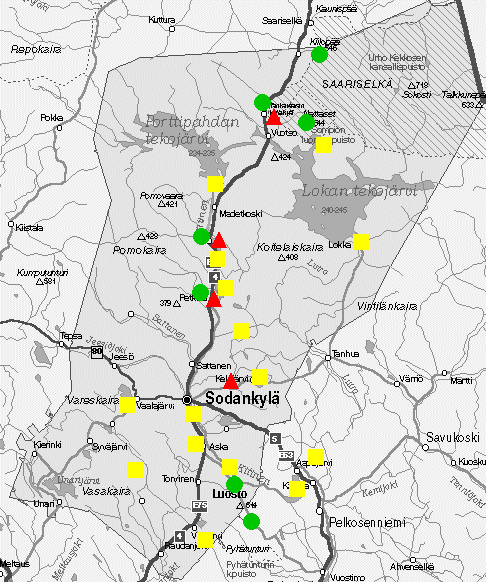
Hanhiaapa bird observation tower
Hanhiaapa is located right after the village of Siurunmaa on route 967 from Sodankylä to Tanhua, 15.5 km from Sodankylä. On the left side of the road there is a track leaving the road on the edge of a cleared area in the woods which leads about 300 metres to the tower.
Birds that gather at the bog in May - June are Bean Geese, Cranes and Whooper Swans. Waders that can be encountered here are the Red-necked Phalarope, Spotted Redshank, Greenshank, Broad-billed Sandpiper and Jack Snipe, among others. The most frequently seen bird of prey is the Hen Harrier. The tower is a good vantage point to observe the migration of the Rough-legged Buzzard in April - May. It is also worth being on the lookout for rarer species of geese. The White-fronted Goose and Bar-headed Goose, for example, have been spotted here.
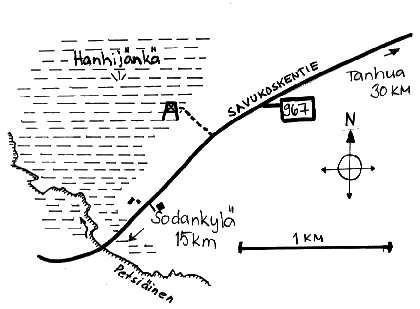
Lake Ilmakki
About 200 metres south of the road to the Vajukoski power station, 35 km north of Sodankylä, there is a parking place on the eastern side of the road. A duckboard path on the western side of the road leads to a bird observation tower on the edge of the bog. There are information signs along the path describing the nature of the area.
At the bog in the spring and summer, one may encounter birds such as the Red-necked Phalarope, Jack Snipe, Broad-billed Sandpiper, Golden Plover and Crane. You may also see at the lake the Common and Velvet Scoter, Long-tailed Duck, Smew, Whooper Swan, and Little Gull. The mating song of the Little Bunting can be heard at the edges of the bog. Birds of prey that can be seen here are the Hen Harrier and, with a bit of luck, the Peregrine Falcon.
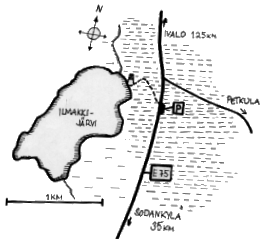
Nesting marsh for whooper swans
13 km from Aska towards Luosto, you can see a boggy area and a pond about 200 meters from the road on the right. Cars can be parked at the site where two paths intersect.
Suolampi (Marsh Pond) is a place where waterfowl, such as the Smew, Common and Velvet Scoter and waders, such as the Broad-billed Sandpiper, Jack Snipe, Wood Sandpiper, Greenshank, Ringed Plover, Spotted Redshank and Whimbrel, gather in spring.
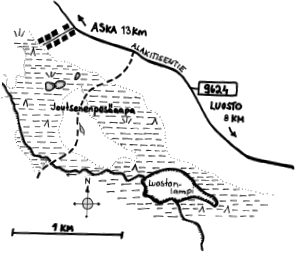
Kaira bog
8 km from Pelkosenniemi towards Sodankylä turn east on the road towards the village of Kairala. A road sign reads LUIRO 6. Drive 5.3 km, turn left at the sign reading LINTUTORNI 6.6 km (Bird Observation Tower). Drive 2.6 km to a boom, where you walk the rest of the way to the bird observation tower, about 4 kms. If the boom is up, you may drive to the path, about 1 km long, that leads to the tower.
In spring and summer, waders such as the Red-necked Phalarope, Broad-billed Sandpiper, Snipe, Whimbrel, Golden Plover, Spotted Redshank and Greenshank as well as Wood Sandpiper can be seen in the bog. Birds of prey seen in the area are Hen Harriers, Peregrine Falcons and Short-eared Owls.
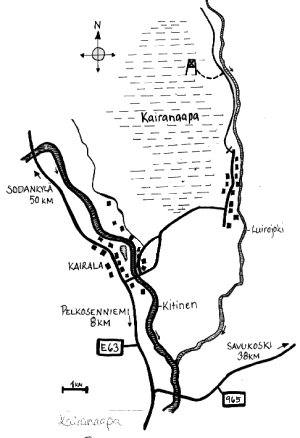
Lake Kelujärvi
Location
After driving 19 km on route 967 from Sodankylä to Tanhua one comes to the village of Kelujärvi. The fields in the village are good to observe from the road. Drive on until you come to the channel between Lake Kelujärvi and Lake Matalajärvi. You can observe the lake from the telescope on the bridge.
Because the fields in the village thaw early in spring, the first migratory birds gather there. Birds that may be seen in the fields are Thrushes, Golden Plovers, Dotterels, Curlews, Whimbrels, Cranes, Sparrowhawks, Short-eared Owls and Hen Harriers. Bar-tailed Godwits may be seen with a bit of luck.
Among others, the Long-tailed Duck, Scaup, Common Scoter, Velvet Scoter and Shoveler may be seen at the lake in the spring and the beginning of summer. Red-throated and Black-throated Divers can be seen almost daily at the lake in the summer. It is worth looking out for Little Buntings in the marshes on the shores of Lake Matalajärvi to the south of the bridge. Cormorants can be seen in the autumn in August - October. Whooper Swans and up to 1000 Goosanders can gather in the autumn at the lake until it freezes. Dippers may be observed at the lake outlet from the bridge. It is worth keeping your eyes open at the lake, because several rare species such as the Great Skua, Little Grebe, Gannet, Great Black-backed Gull and Snow Goose have been seen there.
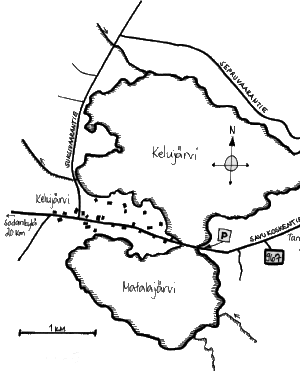
Kiilopää
Location
120 km north of Sodankylä, a road turns right at Kakslauttanen where it ends after 6.2 km at Kiilopää Fell Center. 1, 3 and 6 km nature trails leave from the Fell Center grounds. There is also marked trail to the top of Kiilopää Fell.
The Kiilopää area is a good place to get to know the species inhabiting the fells, such as the Rough-legged Buzzard, Merlin, Willow Grouse, Ptarmigan, Dotterel, Golden Plover, Whimbrel, Lapland Bunting and Snow Bunting. The Willow Grouse and Ptarmigan can be found in the area in winter as well.
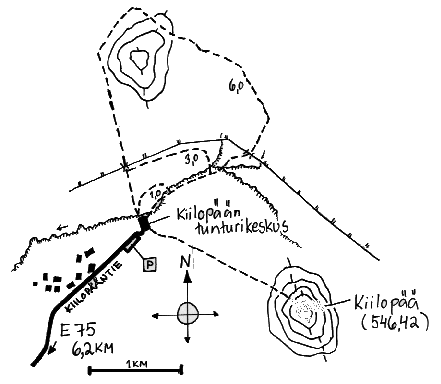
Kohkonen
Location
The road to Pelkosenniemi turns off from the Luosto - Pyhätunturi road. After driving this road about 12 km turn left to the village of Suvanto. At Suvanto, a road turns to the right. Kitinen River and the Kohkonen Reservoir are on the right side of the road all the time. To watch birds, it is best to stop at boggy sites and several places on the shore of the reservoir. The road goes through to the Sodankylä - Pelkosenniemi road. There is also a road from Suvanto to Sodankylä-Pelkosenniemi road on the eas tern shore of the reservoir that bypasses the Kohkonen dam.
The bogs and reservoir gather waterfowl, especially in the spring migration season from 15 April - 20 June, waterfowl such as the Northern Pintail, Wigeon, Tufted Duck, Scaup, Smew, Black-throated and Red-throated Diver, Long-tailed Duck, Common and Velvet Scoter, Garganey and Bean Goose. In the bogs and marshy bays one can encounter the Crane, Red-necked Phalarope, Jack Snipe, Broad-billed Sandpiper, Temminck's Stint, Snipe, Ringed Plover, Spotted Redshank, Greenshank and Whimbrel. You may also see Short-eared Owls, Hen Harriers and Black Grouses.
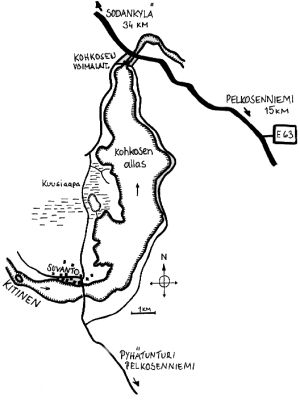
Lake Kulvakkojärvi, Lake Lappalaisjärvi
Location
At the village of Riipi, the road to Vuojärvi turns off. Drive about 12 km on this road, until you turn right onto a logging road to the right and again right immediately at the next intersection. After driving about 2 km on this road Lake Kulvakkojärvi is visible on the left. 4 km from Lake Kulvakkojärvi towards Vuojärvi, Lake Lappalaisjärvi, which is worth a visit, is located on the right.
The Common Scoter and Velvet Scoter both nest at Lake Kulvakkojärvi. The Smew and Bean Geese, among others, may be seen there in the migration season.It is highly probable to see Rustic Buntings in the marshes on the shore. Among others, the Black-throated Diver and Smew nest at Lake Lappalaisjärvi.
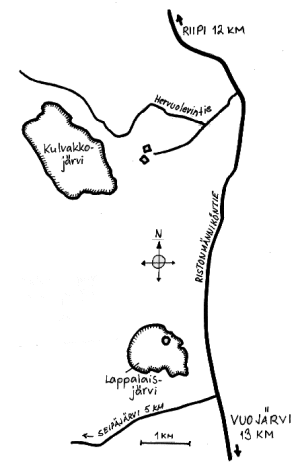
Kurittukoski power station
Location
After driving 52 km from Sodankylä to the north on E 75, turn left 2 km from the Peurasuvanto Holiday Village at a road sign reading KEMIJOKI OY, KURITTUKOSKI. It is about 300 m to the power station. Another good place to observe the reservoir is 1 km from the intersection to the north at the gravel area on the left.
Birds
Waterfowl seen at Kurittukoski in the spring 15 April - 20 June and August - October are the Black-throated and Red-throated Diver, Long-tailed Duck, Common and Velvet Scoter, Scaup and Cormorant. Common and Arctic Terns, Ospreys and the Great Black-backed Gulls, among others, nest near the power station. White-tailed Eagles can be seen fishing here year round.
Kurkiaska power station
Location
After driving 13 km south of Sodankylä, turn left at a sign that indicates KEMIJOKI OY, KURKIASKA. This road goes about 0.5 km to the edge of a reservoir dam and goes on 4 km to a power station. Almost the whole dam embankment provides a good view to the reservoir.
The best time to watch birds is during the spring migration season 20 April - 30 June. The reservoir gathers waterfowl such as the Black-throated and Red-throated Diver, Common and Velvet Scoter, Long-tailed Duck, Smew and Little Gull. The most common birds of prey seen here are Ospreys and Merlins. The reservoir embankments thaw early in the spring and gather migratory birds such as the Shore Lark and Twite that can be seen nearly every year, especially 20 April - 20 May. Flocks of waterfowl collect at the reservoir in the autumn and Goosanders linger up until the reservoir freezes.
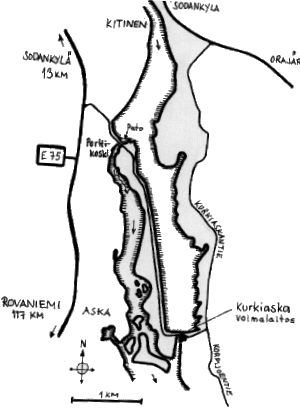
Lintuniemi
Location
1 km south of Sodankylä, on the opposite side of the road from the turnoff to Kittilä, a road turns to the left to the museum. Drive about 2 km to the end of this road. A path starts at the end of the road and goes through fields about 300 meters to the end of a peninsula. At Lintuniemi, the eastern shore of Kitinen River also has a variety of birds. You can get to that area via the road to Orajärvi.
The best time to watch birds is during the spring migration season from 15 May to 20 June. The river, which thaws early, serves as a migration route for waterfowl such as the Red-throated and Black-throated Diver, Common and Velvet Scoter, Long-tailed Duck, Tufted Duck, Scaup and Pochard, and waders such as the Great Ringed Plover, Spotted Redshank, Greenshank, Temminck's Stint, Dunlin and Broad-billed Sandpiper. When the ice breaks up in May, some Common Terns, Arctic Terns and Little Gulls often visit here.The fields of the area gather large flocks of thrushes. One can also see Rough-legged Buzzards, Hen Harriers and Short-eared Owls on the hunt over the fields. Large flocks of thrushes and Yellow Wagtails can be seen in the fields in the autumn also.
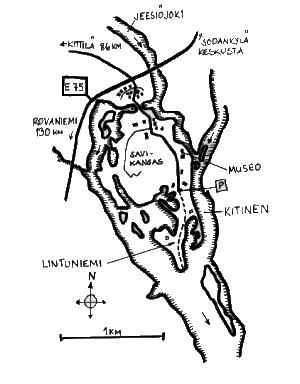
Lokka
Location
After driving east from Sodankylä 46 km on Route 967 to Savukoski, turn north at Tanhua and drive 38 km on Route 9673 to the village of Lokka. It is worthwhile to stop at the Lokka reservoir and look out from the reservoir embankment towards the village. Another lookout is found by driving west from the village of Lokka to the reservoir from the shore. After about 7 km at Hanhireikä the dam embankment appears close to the road on the right. On the left is open bog. Good birdwatching places are found where streams flow into the reservoir, places that are accessible via logging roads. The best way to get to know the reservoir is by boat.
Waterfowl visible at the reservoir are Long-tailed Ducks, Velvet and Common Scoters and Smews. The most common birds of prey are the White-tailed Eagle and Osprey. With a bit of luck you may get to see the Peregrine Falcon. Birds often seen at Hanhireikä are the Waxwing, Siberian Jay, Pine Grosbeak and Rustic Bunting. Lokka is a large lake which gathers many migratory birds and during the migration season arctic waders can be spied on its muddy shores. The birds of the Lokka reservoir are not well-known, and its large bodies of water and marshy shoreline can provide exciting experiences for explorers. Rare species that may be found in the summer at Lokka are, for example, the Glaucous Gull , Northern Gannet and Pomarine Skua, as well as the Lesser Black-backed Gull.
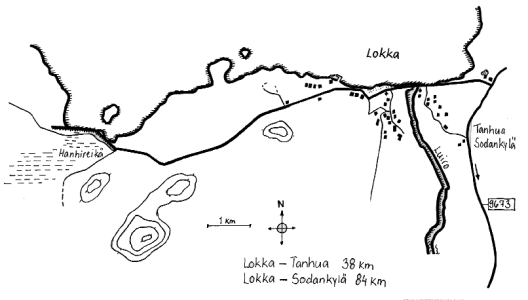
The Luosto nature trail
Location
The 14 km-long hiking trail at Luosto starts at the lower ski lift station at Luosto. The trail goes primarily through forest terrain.
Parrot Crossbills and Common Crossbills and occasionally also Two-barred Crossbills can be seen there year round. During migration years Two-barred Crossbills can be seen with the most certainly halfway through July until late autumn. The Pine Grossbeak is most often seen in April when it can be heard singing. Species seen year round by the trailsides are: the Three-toed Woodpecker, Black Woodpecker, Capercaillie, and Siberian Tit. At the top of Luosto the Whimbrel and Kestrel can be seen in the summertime.
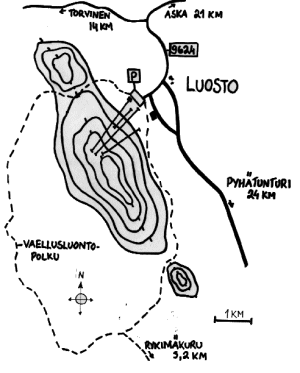
Lake Moskujärvi
Location
20 km north of Sodankylä, the road leading to Moskuvaara turns east from the village of Kersilö. Lake Moskujärvi is seen on the right after driving about 10 km. You can spy out on the lake over the fields from the road. You have to walk along the edges of the fields to get to the lakeshore.
This lake is a gathering place for Whooper Swans in April - May and September - October. Among others, Red-throated and Black-throated Divers and Shovelers can be encountered at the lake in the summer. In the spring the Long-tailed Duck, Common and Velvet Scoter, Scaup, Smew, Pintail and Wigeon can be seen. Birds of prey seen are the Hen Harrier, Kestrel and Short-eared Owl. With luck, Little Buntings can be heard singing in patches of willow growing in the fields.
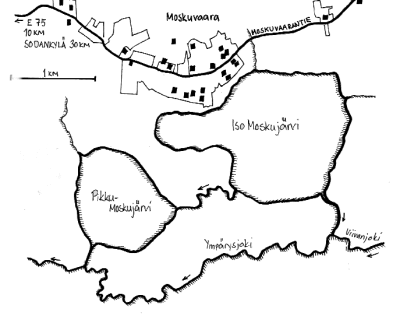
Mätöpeuranaapa
Location
45 km north of Sodankylä and right next to Route E 75, there is a marshy bay about 5 km north of the Yläpostojoki River kiosk. One can get to the shore along a road closed off by a chain. Cars can be parked on the left side of the road which has a widened shoulder at this point.
The best time for birdwatching is spring and the beginning of summer. The grassy bay gathers spring migrants. Whooper Swans and Bean Geese are seen here 15 April - 15 May. Other waterfowl encountered here are the Pintail, Wigeon, Teal, Tufted Duck and Smew. Flocks of Dunlins may be encountered 15 May - 10 June. Other waders seen are the Red-necked Phalarope, Temminck's Stint, Spotted Redshank and Golden Plover. Ospreys can be seen fishing here daily all summer long.
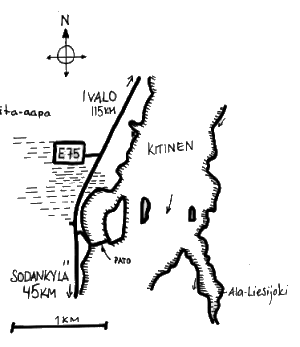
Peurasuvanto
Location
The Peurasuvanto Holiday Village is located 50 km to the north of Sodankylä on the banks of the Kitinen River. There is a bird-sightings collection point at the village from which you may get information about the local bird populations and recent sightings. The river remains open year round. There is also a bird observation tower nearby and a 5 km long trail starts from the Peurasuvanto Holiday Villages grounds.
Birds one can see in the area in the spring and summer are the Bluethroat, Hen Harrier, Sparrowhawk, Short-eared Owl, Hawk Owl and Osprey. The mating calls of the Black Grouse can be heard from the cottages in the spring. Siberian Tits, among others, frequent birds feeds here. White-tailed Eagles fish in the river year round. Parrot Crossbills and Common Crossbills can also be encountered year round on the trail.
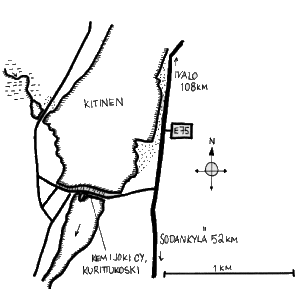
Porttipahta power station
Location
65 km north of Sodankylä, a road turns to the west at a road sign reading "Myllypalontie". This road leads about 1 km to the power station.
There is a good possibility to see White-tailed Eagles year round at the power station. The dam embankments thaw early in the spring and Shore Larks and Twites may be seen there between 20 April - 15 May.
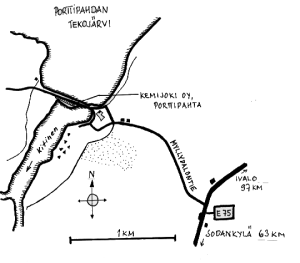
Pyhä-Nattanen
Location
11 km from Vuotso along the road to Sompiojärvi, a path starts to the north and leads about 2 km to the top of Pyhä-Nattanen fell. This fell is in The Sompio Nature Reserve, so it is forbidden to leave the trail when there is no snow cover. There is a refurbished fireguards' shelter at the top of the fell in case of bad weather. There are fine views of the Sompio Nature Reserve and Lake Sompiojärvi from the top.
Bird species inhabiting the fells such as the Whimbrel, Golden Plover, Lapland Bunting, Northern Wheatear and Ptarmigan can be sighted in the summertime.
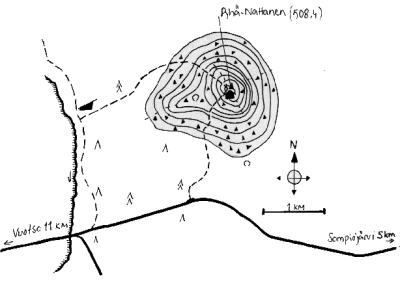
Rykimä gorge
Location
The trail to Rykimä Gorge starts on the right side of the road about 8.5 km on the road from Luosto to Pyhätunturi. You can park your car at the start of the trail. The Kuukkeli rental cabin is about 1 km from the start of the trail, and the Rykimä Gorge day cabin about 2 km.
The trail traverses mostly through dense spruce woods. You can see all year round Parrot, Common and Two-barred Crossbills, Treecreepers and Siberian Tits by the trailside. Birds that can be seen in the spring and summer are the Pine Grossbeak, Rustic Bunting, Goldcrest, Wren, Mistle Thrush and Blue Tit.
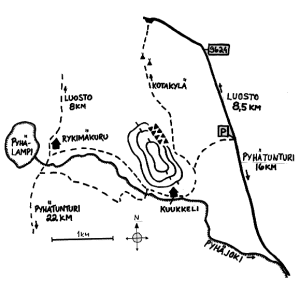
Lake Sompio
Location
There is an eastward bound road marked SOMPIOJÄRVI 16 km from the village of Vuotso. After 16 km the road comes to the lakeshore where there is a Lappish hut (kota), fireplace, Lappish tepee as well as a boat landing.
Birds are best seen during spring migration 20 May - 20 June. Waterfowl that can be observed are, for example, the Black-throated and Red-throated Diver, Common and Velvet Scoter, Smew, Tufted Duck, Scaup, Long-tailed Duck and Goosander, Ruff, Whimbrel, Red-necked Phalarope, Spotted Redshank, Greenshank, Bar-tailed Godwit and Temminck's Stint. White-tailed Eagles fish in the lake from the spring thaw until the lake freezes. The Honey Buzzard arrives to the area in the summer. Bluethroats and Willow Grouse can be encountered in the woods along the shore. It is worthwhile stopping to listen if the Arctic Warbler may be singing.
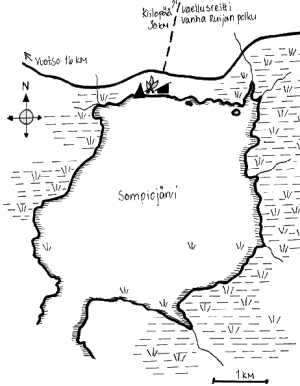
Tankavaara
Location
The Koilliskaira Nature Center is located 10 km north of Vuotso. There are 1, 3 and 6 km nature trails starting from the Center grounds. During the winter there is a 1 km winter-nature trail open.The terrain the nature trail passes through is mostly woods. The longest trail climbs up to the top of Pikku (Little) Tankavaara where there is a watchtower. There is a Lappish hut (kota) on the side of the trail where one can make fires. Information concerning recent bird sightings as well as the nature in The Urho Kekkonen National Park can be ascertained at the Nature Center.
Birds that may be seen along the sides of the trails are the Parrot, Common and Two-barred Crossbill, Pine Grosbeak, Capercaillie, Black and Three-toed Woodpecker, Siberian Jay and Siberian Tit.
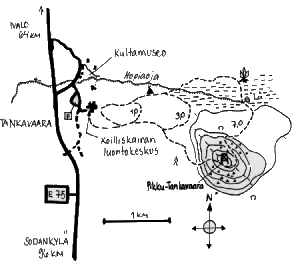
Lake Vaalajärvi
Location
At Vaalajärvi Village, about 15 km on the way from Sodankylä to Kittilä, turn on Meltaus Road no. 952 towards Riipi. After going about 3 km, Lake Vaalajärvi lies on the right side of the road. There are no clear paths on the shore, except the road to the swimming beach on the eastern side.
In the spring and summer it is possible to encounter many kinds of waterfowl at the lake, such as the Long-tailed Duck, Scaup, Common and Velvet Scoter, Pintail, Wigeon. Little Gulls may be seen at the lake throughout the summer. The most common birds of prey sighted are the Merlin and Kestrel. About 5 km from the intersection of the Meltaus Road, the Länsiranta (Western Shore) Road turns to the right. A stream passes under the road at the intersection. It is possible to hear the song of the Arctic Warbler here in the summer.
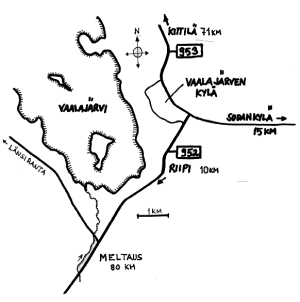
Vajunen
Location
35 km north of Sodankylä there is a road that turns east to Petkula and Vajukoski Power Station, which is a good place to watch birds from. Another good lookout is at the Yläpostojoki River kiosk 3 km north of the Petkula turnoff. Many birds gather about 800 metres south of the kiosk where the reservoir water vegetation is very lush. But it is difficult to park there.
Birds that may be seen at the reservoir in spring and summer are the Red-throated and Black-throated Diver, Long-tailed Duck, Lesser Black-backed, Great Black-backed and Little Gull and Arctic Tern. One may see Cormorants here mostly in September and in June. Ospreys and Peregrine Falcons may be seen flying overhead in the summer. White-tailed Eagles fish in the area throughout the year. The lush shoreline near route E 75 gathers ducks and waders such as the Temminck's Stint, Red-necked Phalarope, Broad-billed Sandpiper, Jack Snipe and Ruff in the spring. Because the dam embankments at the power station thaw early, one may see the Shore Lark and Twite there from 20 April to 20 May.
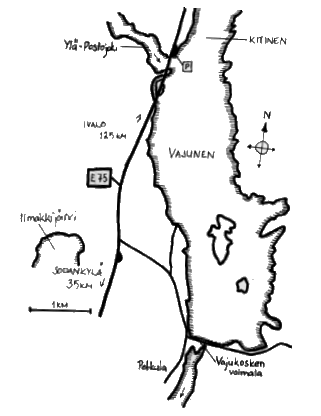


 : Nature trail
: Nature trail
 : Bird lookout
: Bird lookout
 : Birdwatching tower
: Birdwatching tower






















